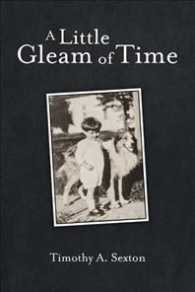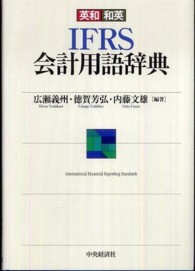- ホーム
- > 洋書
- > 英文書
- > History / World
Full Description
China is a multicultural country home to fifty-five ethnic minority groups, yet due to linguistic and cultural barriers many of these groups remain understudied or unknown in the West. The Qiang, one of modern China's officially recognized ethnic minorities, is also China's longest-standing ethnoracial identity marker that has existed since the earliest recorded history of China. Creative Belonging investigates the formation and evolution of the Qiang as a people, a concept, and a cultural history in China. It further examines how the contemporary Qiang ethnic group interacts strategically with mainstream Chinese society, challenging the historically entrenched hierarchies between the sociocultural "centers" of China and its ethnic "peripheries."
This book is based on years of ethnographic and textual-archival research in the Himalayan regions of southwest China, where the contemporary Qiang group resides. Drawing on a diverse range of official and local political discourses and previously unstudied literary, historiographical, and cinematic works, Yanshuo Zhang illuminates how the Qiang have carved out spaces of "creative belonging" within the parameters of multiculturalism in contemporary China. Rooted in ethnographic and textual-archival research, the book presents original materials produced by Qiang indigenous writers, scholars, artists, grassroots village cultural activists, and entrepreneurs at both the local and the global levels. Creative Belonging invites readers to rethink ethnicity and national belonging in China by centering minority groups' efforts to expand the meanings and implications of "Chinese culture."
Contents
Introduction: Conceptualizing "Creative Belonging": Towards an Interdisciplinary and Multicultural Paradigm of Chinese Studies
Part I: Imagining the "Qiang" in Chinese National Narratives and Minority Scholarly Debates
Chapter 1: From "Barbarians" to "Brothers" and Cultural Guardians: Race, Ethnicity, and the Invention of the "Qiang" in Chinese Textual Traditions and National Discourses
Chapter 2: "King Yu Rose from West Qiang": Minority Scholarly Production and the Cultural Politics of Imaginary Ancestry in the Qiang Regions of China
Part II: Visualizing the "Qiang" in Cinema, the Built Environment, and Tourism
Chapter 3: A Village's Affair with the World: Visual Culture and Representing the Qiang Native Village in Transnational Cinema and Tourism
Chapter 4: The Run-away Minority Bride: Fluid Indigeneity and Ethnographic Poetics in Qiang Indigenous Cinema
Part III: Reconstituting the "Qiang" in Literary Voices and Cultural Activism in the Himalayas
Chapter 5: Between the Languishing Ethnic Mother and the Bewitching "Poisonous Cat:" Gender and Commercialization in Contemporary Chinese Minority Literature
Chapter 6: Paradise Recrafted: The Problems of Secular Modernity in Chinese Multiethnic Literature and Village-level Cultural Activism
Conclusion: The "Qiang" as Concept, History, and People
Bibliography
Index







